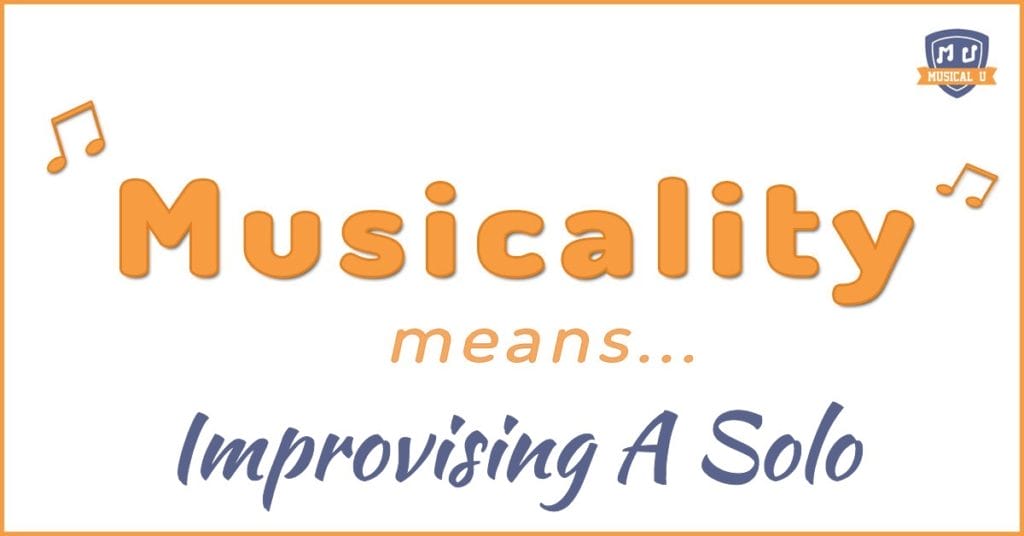An incredible solo drives fans wild.
From jazz music and mind boggling drum solos to rock guitar jams and vocal gymnastics, some of the greatest music of all is created on the spot and in the moment. With technical prowess that blows away the audience, the greatest musicians are masters of improvising memorable solos.
Watch Slipknot’s Joey Jordison concoct a mindbending drum solo on the band’s 2002 release Disasterpieces:
The musicians that live on in the annals of music continue to amaze us with their incredible ability to create unforgettable music in the moment.
But improvisation isn’t just for the musical legends. Anyone from beginner to pro can enjoy the creativity and excitement of improvising a solo.
What is Improvisation?
“Composing will always be a memory of inspiration; improvising is live inspiration, something happening at that very moment. Do not fear mistakes. There are none.” – Miles Davis
In the most general sense, when a musician improvises a solo, they are making up a new melody or drum solo that is not written down and hasn’t been played before that moment. The best improvisers create on-the-spot compositions that are both musical and technically challenging, while also fitting within the context of the entire tune.
Mastering improvisation takes more than a good ear. Musicians that improvise solos will work within the established harmonic framework, borrow rhythmic and melodic snippets, and give these elements their own original twist. They make it look easy, like they are just “winging it” in performance.
Here’s trumpet master Wynton Marsalis playing around with rhythm and melody in an exciting solo:
While nearly every genre of music has some sort of improvisation, many of the best improvised solos can be found in rock and jazz music. The very foundations of jazz were built up on the blues and the oral traditions of the African diaspora. A great jazz musician can improvise everything from sassy slow solos to dizzyingly fast flurries of notes that make your head spin.
Improv in Jazz
In this clip, James Carter of the World Saxophone Quartet rips his sax to shreds with an improvised solo that is both musical and rhythmic:
The solo goes by lightning-quick, with notes so crazily high that the sax ceases to sound like a woodwind and instead sounds like some lunatic mechanical beast, drawing some laughter from Carter’s awestruck fans.
Want to develop the coveted skill of jazz improv? Check out Learning Jazz Improvisation, with Bob Habersat and Paul Levy. In this great resource, you will learn some practical skills to help your overall musicianship as you learn how to improvise.
Improv in Rock
Rock music has its own share of improv legends and is rife with guitar and drum solos that take music to an eleven. In this clip, Slash from Guns ‘n’ Roses shows us how it’s done with an incredible guitar solo:
Want to learn a little bit more about great rock improvisers? Check out They Carved Their Names in Rock: 5 Giants of Rock Improvisation at Musical U.
Vocal Improvisation
It isn’t just instrumentalists that know how to improvise a great solo. Vocalists throughout the globe stretch their vocal chords with improvised solos. You can find singers from opera to pop to blues proving that vocalists are just as awe-inspiring as instrumentalists when they perform solos. Listen to Ella Fitzgerald show off some scat singing as she jams out to “It Don’t Mean a Thing”:
Why Improvise?
What is the value in improvising music, especially if you can read music? There are many reasons why you should learn how to improvise, not just for solos, but for other musical situations.
Improve Your Musicianship
Great musical improvisers have great musicianship.

It means that they are well-versed in ear training and aural theory, they understand harmony and rhythm, they understand musical form, and they have spent countless hours in the practice rooms perfecting their craft.
While the best musical solos might seem like they are quickly and easily made in that very instant, the reality is that it takes a lot of preparation to be able to create great music at a split second. And that takes real musicianship.
Improve Your Listening Skills
When you improvise a solo, you are forced to really listen.
You have to listen to the music around you and incorporate that into your solo. You need to listen for harmonies and the band playing behind you. Even as you zip through dozens of quick musical riffs, one after the other, you need to listen to everything around you and to yourself, too, to make sure that your solo doesn’t only showcase your talents but the talents of the other musicians around you.
Make Yourself More Marketable
Goes without saying: being a great improviser makes you much more marketable both in live and recorded sessions.
Why?
As an improviser, you can work around any bizarre musical snafus that might happen in the studio, performance hall, or stage. In a recording session you won’t waste time (or money) because your level of musicianship is so high that you will know exactly what to play and when to play it. Playing alongside you will be a good experience for fellow musicians because they know that you can hold your own and are reliable in any pinch.
Improve As A Performer
 We’ve already mentioned it, but being a good improviser means that you are not easily frustrated when live performances or a recording situation go awry.
We’ve already mentioned it, but being a good improviser means that you are not easily frustrated when live performances or a recording situation go awry.
Instead, you can quickly work around it when the drummer misses a beat, someone misses their entrance, the director makes a mistake, or the vocalist forgets their lines. Because you are a trained improviser, you already have at your fingertips (or vocal chords) the key to musical success in a tight situation.
Become More Confident
As you become more adept at improvising solos, your confidence will build. If someone asks you to take the lead or to fill in on the fly, you aren’t stressed because you have done this dozens of times before.
This will manifest as confident playing, no matter the musical situation. You will know exactly what to do and when to do it. And others will notice, especially your fans.
How to Develop Your Improvisation Skills
Is it easy to develop good improvisation talents? What if you have never improvised a solo before or have just begun your musical journey? Can it be too late to learn how to improvise?
These questions, among others, can cause anxiety in aspiring improvisers. Here are five tips to help you put any self-doubt in the back of your mind, and as Nike declares, “Just Do It”…
1. Use Online Resources
There might not be any better time to be a musician. Besides being able to create music quickly with contemporary audio technology and then share it quickly throughout the world via the internet, you also have access to millions and millions of articles, videos, and other resources to help you develop your musicality.
Below is just a small sampling of online resources to help you develop improvisation skills:
- For the jazz musicians out there, check out Improve Your Improv: Listen to the Rhythm Section with Stefan Hall
- Guitarists the world over can learn the basics of improvising a great solo with How to Freestyle a Guitar Solo
- Learn the basics of playing by ear from talented singer and pianist Sara Campbell in Finding the Notes Yourself
- Patterns and Playgrounds by Christopher Sutton gives you four unique ways to develop your improvisation skills
2. Practice, then Practice More
 Being great at musical improvisation takes a lot of practice, practice, practice. And this means more than playing along with your favorite jam by yourself in an isolated room.
Being great at musical improvisation takes a lot of practice, practice, practice. And this means more than playing along with your favorite jam by yourself in an isolated room.
This means learning scales, drum rudiments, singing in tune, and playing with good harmonies. This means an understanding of musical structure and music theory, developing your overall ear training and musicianship, and spending time developing the skills you will need in performance.
3. Play Live
While you can practice playing along with your favorite artist’s track, you will learn more if you jam with other musicians. This can be in performance or just at a rehearsal, but learn how to play with other musicians in a live setting.
This will build your skills as well as your confidence – your fellow musicians can offer you both encouragement and helpful criticism, and if you improvise a solo live, your fans’ responses will be all you need to know if you have nailed that solo.
4. Play with Recordings
We can’t all grab a live band every day, so take the time to find recordings of some of the legends in your musical niche and play along with them. Learn their instrumental or vocal riffs and play along. What scales are they using? What rhythms? How did they improvise solos that worked within the entire song?
There are plenty of tracks online that have just backing chords, giving you a chance to play along.
For example, if you are a drummer, you can play along with this drumless Heavy Rock backing track and create your own original drum beat.
For guitarists and other instrumentalists, use a simple backing track in A minor and C major to practice simple solos and harmonization.
5. Be Confident
After you have practiced for the gig, feel confident in your improv skills. And don’t worry if what comes out of your instrument isn’t exactly what you expected – the beauty of improvisation is that it is different every time, and fitted exactly to the circumstances.
Sometimes you’ll get a high energy vibe from the audience and will feel like you are on fire, and sometimes a musical solo a bit more nuanced is needed. But in all cases, be confident in your playing. Your audience will love you for it!
How To Improvise a Solo
We’ve talked about how you can develop good improvisation skills in the practice room, about some great online resources, and even listened to some great improv examples. But how do you actually improvise a solo?
1. Practice
 Yes, it was already mentioned, but to play on the fly, you need to be prepared. Your fingers need to be able to run up and down scales without a flaw, your singing should be in tune, and your drumming should be on time. You need to be a prepared musician, no matter what your skill level.
Yes, it was already mentioned, but to play on the fly, you need to be prepared. Your fingers need to be able to run up and down scales without a flaw, your singing should be in tune, and your drumming should be on time. You need to be a prepared musician, no matter what your skill level.
2. Know the tune
It helps if you know the tune. This can’t always be the case, and for some musicians like percussionists, it is possible to improvise a decent solo without having any idea where the song is going. But the best bet is to know the tune inside and out.
3. Take cues
You don’t want to be the person that gets so carried away with their solo that they wreck the song for everyone else or just get lost. While fans are forgiving, your bandmates or manager might not be.
The solution? Watch for cues. This could be a musical cue that signals the end of the solo, a simple nod of the head from another musician, or just something as simple as “your fingers are about to fall off and you need to move on”. Bottom line: be mentally present during your solo.
4. Timing is everything
One of the most important things to remember when you are improvising a solo is to keep time. Are you supposed to jam for eight bars? Make sure it is just eight bars. Did you just play the conga solo of the century? Then be sure that when beat 1 hits that you are also on beat 1, ready to go with the rest of the band. Don’t get lost, and if you do, just watch for cues from the band.
If you don’t, you run the risk of becoming the overbearing show-off that nobody wants in their band, à la Animal from the Muppets in his accompaniment during Rita Moreno’s “Fever”:
5. Listen
Improvising is really just taking what you have practiced and playing it in creative ways in a live setting.
Yes, you might have never put these particular notes or rhythms together before, but in some ways they are familiar, and you will find that certain riffs will become your go-to favorites.
While you are improvising, be sure to really listen to what happened before and what is going on. Connecting melodic, harmonic, and rhythmic material from the song in your solo will show expertise, even if your audience doesn’t realize it.
6. Experiment
Always be ready to experiment with something new when you improvise. This doesn’t mean practicing that extended technique that you only got right once in the practice room, but it does mean going out on a limb with your material.
An easy way to start is with a riff from the song itself then let it naturally evolve as you play. Add in some notes or new harmonies, and change up the rhythm some. Mix in a string of notes or some new timbres that weren’t there before.
Keep experimenting, moving onward, until you have journeyed far from the starting point. But keep it musical.
Cultivating Musical Spontaneity
Now that we’ve looked at why you should learn to improvise, how to do it, and the skills involved, you are ready to start your journey of improvisation. Musical U has an incredible community of musicians, students, teachers, and professionals to help you develop your improvisation skills. In fact, there’s even a slew of dedicated improvisation modules!
The spontaneity involved in improvisation is not random or “guesswork” – it comes from knowing what to play and when to play it, and being confident in doing so!
Remember that improvisation, like any skill, will take some time. But keep working on it, and you will be surprised the places you will go.







